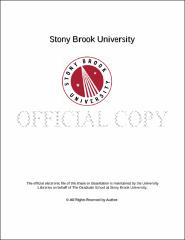| dc.identifier.uri | http://hdl.handle.net/11401/76398 | |
| dc.description.sponsorship | This work is sponsored by the Stony Brook University Graduate School in compliance with the requirements for completion of degree. | en_US |
| dc.format | Monograph | |
| dc.format.medium | Electronic Resource | en_US |
| dc.language.iso | en_US | |
| dc.publisher | The Graduate School, Stony Brook University: Stony Brook, NY. | |
| dc.type | Dissertation | |
| dcterms.abstract | In this thesis we study various notions of surface braidings in 4-space, and their applications to the construction of singular fibrations on smooth oriented 4-manifolds. We define the notion of braided link cobordisms in <bold>S</bold><super>3</super> × [0,1], which generalize Viro's closed 2-braids in <bold>S</bold><super>4</super>. We prove that via isotopy any properly embedded oriented surface <bold>W</bold> in <bold>S</bold><super>3</super> × [0,1] can be brought to this special position, and that the isotopy can be taken rel boundary when the boundary already consists of closed braids. These surfaces are closely related to another notion of surface braiding in <bold>D</bold><super>2</super> × <bold>D</bold><super>2</super>, called braided surfaces with caps, which generalize Rudolph's braided surfaces. We use these to construct broken Lefschetz fibrations on smooth 4-manifolds. We first consider the case when the 4-manifold <bold>X</bold> has connected non-empty boundary, and construct the desired fibration as the composition of a covering <bold>X</bold> &rarr <bold>D</bold><super>2</super> × <bold>D</bold><super>2</super> branched along a singular braided surface with caps, with the projection map <bold>pr</bold><sub>2</sub>: <bold>D</bold><super>2</super> × <bold>D</bold><super>2</super> &rarr <bold>D</bold><super>2</super>. Proceeding in this way gives us the ability to specify the behavior of our fibration along the boundary of <bold>X</bold>. Broken Lefschetz fibrations on closed manifolds are then obtained by combining this result with a construction of Gay and Kirby. This allows us to reprove earlier existence results due to Akbulut and Karakurt, Baykur, and Lekili, giving a more concrete geometric approach to constructing these fibrations. | |
| dcterms.available | 2017-09-20T16:50:10Z | |
| dcterms.contributor | Viro, Oleg Y | en_US |
| dcterms.contributor | Sullivan, Dennis | en_US |
| dcterms.contributor | Plamenevskaya, Olga | en_US |
| dcterms.contributor | Rocek, Martin. | en_US |
| dcterms.creator | Hughes, Mark Clifford | |
| dcterms.dateAccepted | 2017-09-20T16:50:10Z | |
| dcterms.dateSubmitted | 2017-09-20T16:50:10Z | |
| dcterms.description | Department of Mathematics. | en_US |
| dcterms.extent | 92 pg. | en_US |
| dcterms.format | Application/PDF | en_US |
| dcterms.format | Monograph | |
| dcterms.identifier | http://hdl.handle.net/11401/76398 | |
| dcterms.issued | 2014-12-01 | |
| dcterms.language | en_US | |
| dcterms.provenance | Made available in DSpace on 2017-09-20T16:50:10Z (GMT). No. of bitstreams: 1
Hughes_grad.sunysb_0771E_11926.pdf: 674454 bytes, checksum: 450b59884fe10143d5c49307d802b6a6 (MD5)
Previous issue date: 1 | en |
| dcterms.publisher | The Graduate School, Stony Brook University: Stony Brook, NY. | |
| dcterms.subject | 4-manifolds, geometric topology, knot theory, Lefschetz fibrations | |
| dcterms.subject | Mathematics | |
| dcterms.title | Braiding non-ribbon surfaces and constructing broken fibrations on smooth 4-manifolds | |
| dcterms.type | Dissertation | |

